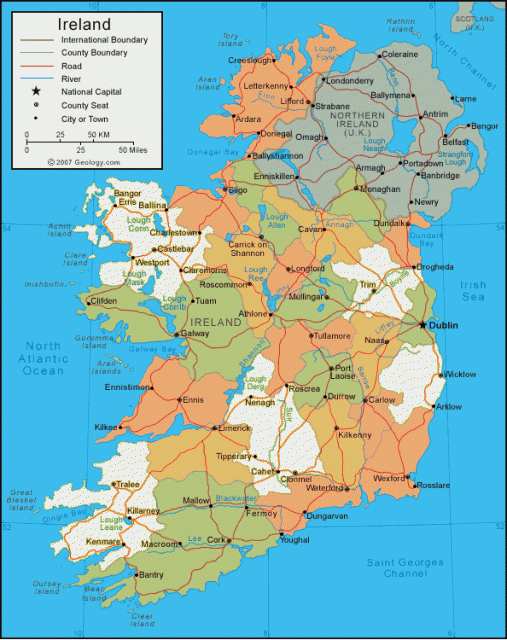Ireland
Area 27,135 square mi (70,280 square km)
Population 4.613 million 2014
Capital Dublin
Highest Point 3,414 ft (1,041 m)
Lowest Point 0 m
GDP $245.9 billion 2014
Primary Natural Resources zinc, lead, natural gas, barite, copper, gypsum.
THE REPUBLIC OF Ireland covers five-sixths of the island of Ireland and shares its only border with Northern Ireland, which is part of the UNITED KINGDOM of Great Britain and Northern Ireland, also known by the historic name of Ulster. Ireland is a republic with a president as head of state and a prime minister as the head of government. Its legislative branch is a bicameral parliament. Ireland is divided into four provinces and 26 counties. English is widely used throughout Ireland, but Gaelic is also spoken along the western coast. Ireland's major cities are Dublin, Cork, Limerick, Waterford, Galway, Dundalk, and Kilkenny.

Ireland's terrain is mostly level to rolling interior plain with rugged hills and low mountains. The west coast is studded with sea cliffs, while the east coast of Ireland has few indentations. The central part of Ireland consists of bogs, meadows, and lakes. The chief rivers in Ireland are the Shannon, Boyne, and Blackwater. The temperature ranges from 40 degrees F (4 degrees C) in the winter to 62 degrees F (16 degrees C) in the summer. Ireland receives an average rainfall of 40 in (102 cm) per year.
Human settlement in Ireland goes back more than 10,000 years during the Mesolithic period. Ireland experienced waves of migrations in its early history. The Gaels, who are the ancestors of the modern Irish people, first settled in Ireland in 700 B.C.E. Christianity arrived in Ireland around the third century, although it was through St. Patrick's missionary efforts between 432 and 465 that it took root, making Ireland a center of Christianity in early medieval Europe.
England began its control of Ireland in the 12th century when Dermott MacMurrough of Leinster sought the assistance of Henry II of England in his battles against other Irish chieftains. The conquest of Ireland was complete in 1541 when Henry VIII was declared king of Ireland by the Irish Parliament following a rebellion. Under the Tudors, England began the “plantations,” which was systematically settling parts of Ireland with English settlers. Ireland was also pulled into the English Civil War and suffered under the resulting rule under Oliver Cromwell in the 17th century.
During the Restoration in 1660 under Charles II, the Irish Catholics were relieved of the persecutions imposed upon them. With the succession of James II in 1685, they were hopeful of having a Catholic on the throne again. Even though James II was deposed during the Glorious Revolution of 1689, Irish Catholics continued to recognize him as their king. In 1690, the forces of King William defeated the forces of James II in the Battle of the Boyne, resulting in the Penal Laws, which not only marginalized Irish Catholics from the political and economic life but also witnessed the rise of an Anglo-Irish elite. Economic conditions under absentee landlords led to the Rebellion of 1798.
Through the Act of Union in 1801, Ireland became part of the United Kingdom of Great Britain and Ireland. By 1829, Irish Catholics benefited from the Catholic Emancipation Act. Between 1845 and 1851
the Great Famine ravaged throughout Ireland, which reduced its population from 8 million in 1845 to 2 million in 1851 due to starvation and emigration. The famine exposed the flaws in the Irish tenure system and British governance. The latter half of the nineteenth century was consumed by the question of home rule for Ireland. Home rule remained an intractable question because Ireland was divided between the Irish Catholics who supported an independent parliament and internal autonomy and Protestants in Ulster who wished to remain loyal to Westminster.
In 1920, after the cataclysm of World War I and a guerrilla war against the British army, the Government of Ireland Act divided Ireland into twenty-six southern counties that were represented by its own parliament in Dublin, and the six counties in Ulster that continued to be represented in Westminster. The Anglo-Irish treaty retained allegiance to the British sovereign and naval bases on the Irish coast. In 1937, the Irish Free State became Eire, which repudiated the Anglo-Irish Treaty of 1921.
During World War II, Eire declared its neutrality, depriving Britain use of naval bases in the southern coast. In 1948, the Republic of Ireland Act severed all ties to Britain, the Empire, and the Commonwealth, while Northern Ireland remained loyal to the Crown. In turn the British parliament passed the Ireland Act, which gave rights to all citizens of the Republic of Ireland who traveled to Britain. With the outbreak of violence in Northern Ireland in 1972, the Republic of Ireland and Britain have since cooperated against the Irish Republican Army and other terrorist groups. In 1973, the Republic of Ireland joined the European Economic Community. In 1998, the Republic of Ireland has been a participant in the Good Friday Agreement, in the resolution of “The Troubles” in Northern Ireland, though efforts have stalled in recent years. In 1999, Ireland adopted the euro as its currency. In 2001, a majority of Irish citizens vetoed the Treaty of Nice because of doubts on the expansion of the EUROPEAN UNION (EU). In 2004, the Republic of Ireland assumed the presidency of the EU, tackling issues such as drafting a new constitution for Europe.
Ireland has had a rapidly growing economy in recent decades, growing at an annual rate of 8 percent between 1995 and 2002. Industry makes up for 38 percent of the GDP, while services account for 49 percent of the gross domestic product. Much of its economic growth was due to its exports in technology, followed by consumer spending, construction, and business investment. Ireland's chief trading partners are Britain, the UNITED STATES, GERMANY, FRANCE, JAPAN, and the NETHERLANDS.